Posted on April 2, 2016
Staying safe

We held off getting most of our safety gear until the last minute. Partly, this is because things expire (flares); batteries die (EPIRB); and some items need to be re-armed (inflatable PFDs) or re-certified (life rafts) after a few years. Partly, this is because the category of safety gear is a never-ending rabbit hole of expensive tech that will hopefully never be used. For example: a dip into the forums yesterday for advice on whether to mount our EPIRB to the cabin wall or keep it in our ditch bag led to EVERY SINGLE PERSON advocating for multiple EPIRBs–one for the wall, one for the ditch bag, and personal locator beacons for everyone on board. Our EPIRB cost $400. Personal locator beacons are between $200-$300. We already have a VHF with DSC, and expect to have a sat phone before heading offshore. How many ways are enough for communicating with the Coast Guard?

So we’re waited until we could better evaluate our finances and our actual needs, and pared down our lists of what we think is important based on professional advice and real-world accounts of problems. Of course, no one is asking us how many EPIRBs we are carrying. Instead, they are asking about two things: hurricanes and pirates. As an obsessive reader of sailing blogs, there are certain topics that are so redundant as to be universal. Apparently none of our landlubbing friends have read these blogs, though, so let’s run through the standard reassurances.
Hurricanes: We live in Wisconsin. By the time we hear about a hurricane or cyclone, it’s either about to hit the East Coast–making for excellent television of gusty palm trees and reporters being knocked off their feet; or it has already hit some part of the world–making for excellent television of devastated villages and wrecked fishing boats. In places where hurricanes are a frequent threat, the process is a little different. People know a good week in advance when a hurricane is developing. The storm’s progress is tracked obsessively by those with something to lose; and while it’s difficult to predict with exactitude when and where the storm will hit, people generally have plenty of time to prepare. Hurricanes are huge. They are not like the tornados we see in the midwest–popping up in the course of an afternoon, without warning, from a thunderstorm turned violent. You can see a hurricane from space.
The other thing about hurricanes: they have a time and a place. While it might seem that the ocean is an open book for our free-wheeling sailboat ways, the reality is that we will not be visiting the parts of the world where hurricanes are likely to land, during the season they’re likely to show up. That means avoiding a section of the tropics, from say North Carolina to southern Nicaragua, from early June until the end of November, more or less.

Hurricane history, courtesy of NOAA
So, we really don’t expect to be ambushed by a hurricane. That doesn’t mean we aren’t taking precautions to outfit our boat, if we happen to find ourselves in an unexpected storm; but the biggest precaution we are taking involves having access to good weather information, and a relaxed schedule so that we can wait to travel during favorable weather windows.
Pirates: Pirates are real, and they are not hilarious or sexy like Jack Sparrow. They are armed with automatic weapons, and travel in very fast boats with big outboards. The thing is, there aren’t a lot of them, and they’re in very specific locations. If you really want up-to-date information on global piracy affecting cruisers, please look at Noonsite, the best aggregate source we’ve found. Piracy is real, but we won’t be visiting the places where they hang out.
We’re much more likely to run into run-of-the-mill petty crime, just as we would if we were RV-ing across the US. While we might be middle class in the States, by income we are in the global top 1%. We’ll be as much a target as any American tourist, and we’ll be using pretty standard precautions to try and avoid getting into unfortunate situations–locking our boats; not wearing flashy jewelry (not a problem, as we don’t have any) or super-nice clothes (ditto); and avoiding places that have a reputation for not being safe. The most common items for theft among cruisers? Dinghies, outboard engines, and anything left overnight in the cockpit. Maybe not a reason to stay home.
Lately, we’ve been asked a lot about defending ourselves with our guns. So…we don’t have any of those. I swear, I want to you keep hunting, and send us over some venison when you get a buck, but it’s still true that the best way to be shot by a gun is to own a gun. Even if we were people who felt safe around guns, we wouldn’t be bringing one on the boat. Very few governments want you sailing into their ports armed, and will ask you to surrender any firearms at your port of entry. If you want to retrieve your weapon, you have to return to the spot where you left it and then immediately leave the country–not so great for traveling. If you decide to lie and conceal a gun aboard, you run the risk of having your boat confiscated. None of these things appeal to us. So no, we won’t be carrying a gun.
Safety is a big deal, and traveling with our kids makes us very cautious. If you’re not a sailor, there’s a good chance you’re worrying about the wrong things. Please know, we take safety very seriously around here, and we’re doing our best to thoughtfully prepare ourselves.



“God” knew she/he could not be everywhere: therefore the mothers were invented! Love, Mom (aka THE Babuela)